
Imagine being thrown about in your small yacht surfing down a 20-metre wave. You’re in the Southern Indian Ocean, it’s freezing, you’re exhausted and soaked through. You’re days or weeks from land. You have no GPS. You’re alone.
Suddenly you’re over the side, flailing in the huge seas, tied to your boat by lifelines. Moments later you’re tossed back on board …
Nearly 30 years ago Australian Kay Cottee sailed her 11.2-metre yacht Blackmores First Lady out of Sydney Harbour hoping to be the first woman to circumnavigate the world alone, without stopping, without assistance, by way of both hemispheres and the five southernmost capes.
On 5 June 1988, after 189 days at sea, Cottee returned victorious: the first woman to achieve this feat (and the fastest woman around the world generally).Others had sailed before her, as have others since, including teenage Australians Jesse Martin in 1999 and Jessica Watson in 2010, all solo sailors lured into the deep oceans by some metaphysical force. What was it like out there alone, back in the 1980s, with no social media and limited communications?
Reopening Blackmore’s First Lady
First Woman, a new small core exhibition launched today at the museum opens a window into this world. With stunning footage taken on board Cottee’s yacht Blackmores First Lady and multimedia programs exploring the voyage, the exhibition works as a prelude to a visit on board the yacht in the gallery alongside. Visits are guided by volunteers at designated times.
One area of the exhibition explores the sailing and navigation challenges and the practical dangers faced by solo sailors generally. How did Kay Cottee navigate? How did she steer, sleep, bathe? How much water did she take? Did she use a desalinator? Did she have satellite navigation?
Another area probes the intangibles, the personality and character of this particular solo sailor – Kay Cottee the 34 year-old woman who knitted and crocheted as she navigated treacherous seas, ice and shipping lanes, preparing meals from tinned or dried food, eating chocolate, writing, reading, listening, all the while talking to her giant Teddy bear, Ted her first mate, which Kay Cottee has lent to the museum for display. How did she cope being alone at sea for six months? How would you cope?
The adventure
In preparation for the voyage, Cottee had consulted a sports psychologist to combat her fears, including hallucinations. She made a rule of not hosting imaginary people on board. ‘Happy thoughts make happy people’ was her mantra. Ted was not an imaginary person.
Talk to Ted more and more every day – ask his opinion of things now and he doesn’t hesitate to give one either, he’s a bit cynical! (Kay Cottee log entries, 26 December–8 January, from First Lady 1989.)
Cottee was homesick the first few months and cherished radio talks with family, friends and officers from ships and landmarks passed. She remained vigilant about her mental health.
My imagination is giving me curry again. For two days we’ve drifted near this bloody island [Ilha da Trindade near Brazil] and all I’ve visualised are boats and pirates coming to get me. Black out the port lights or slink around in the dark. (Kay Cottee log, 16 Feb 1988, from Kay Cottee First Lady 1989.)
‘The rest of the world didn’t seem to exist anymore…’
Generally, Cottee settled into life on the water within the weeks after her relief at rounding the Horn with a makeshift boom repair.
Her daily routines involved checking navigation, monitoring steering, changing sails, checking weather forecasts, writing her log, regular radio communications with her marine radio base, completing maintenance and repairs, cooking, reorganising food storage, listening to tapes, reading books, crocheting, knitting, doing yoga on her galley floor, bathing and washing (always in salt water and weather dependent), studying radio frequencies, and when in radio range talking on the radio and doing media interviews.
Knock-off time was 1730 hours – 5.30 pm – when she had a gin and lemon (‘Forgot the tonic’) or brandy and nibbles out on the deck, whatever the weather – enjoying a sundowner and a good book.
The yacht Blackmores First Lady allows visitors to broach the solo sailor’s private world, fitted out as it is as a historic building. They can enter the tiny cabin, Cottee’s refuge and nest for six months, in around January 1988. Kay Cottee was in the cold and wild Southern Ocean when she cracked her boom with the spectre of Cape Horn ahead of her, repaired it to limp around its bleak towering cliffs, and spent Christmas and her birthday alone, all momentous events in the life of a long-distance sailor. A rare experience for museum visitors.
—Daina Fletcher, Senior Curator.
See Blackmore’s First Lady as part of our FREE galleries ticket.



























